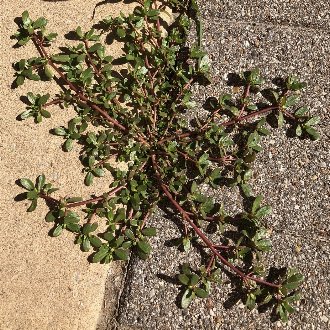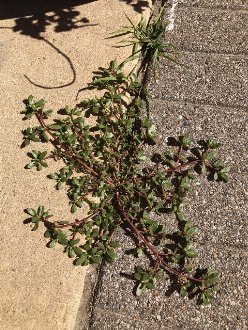Common Purslane (Portulaca oleracea L.)
Also known as little hogweed.
↑Range - Expand
| Legend | Color |
| Native or Introduced | |
| Native or Introduced or Not Present |
This tentative map is based on our own research. It may have limited data on Canada and/or Mexico, and there is some subjectivity in our assignment of plants as introduced vs. expanded. Read more in this blog post.
Although this plant occurs somewhere in each of these regions, it may only occur in a small part of some or all of them.
Although this species is thought to originate outside North America, there is evidence that Native Americans were consuming it as food prior to European colonization. As such, it is uncertain whether to treat it as introduced or native. Most sources treat it as introduced but BONAP marks it as adventive. We treat it as uncertain, but note that it has been in North America for many hundreds of years.
↑Habitat
Purslane is found on sunny, disturbed sites, with a preference for dry sites with poor soil. Mostly found in anthropogenic habitats, especially cities, where it frequently grows in cracks in pavement, concrete, brick, or stones.
Although purslane can grow well in just about any soil type, it is usually limited to more adverse soil conditions such as highly sterile soil, as it gets outcompeted by other plants in richer soils.
↑Life Cycle
Purslane is a succulent annual using CAM Photosynthesis, a water-conserving mechanism that demands high light levels.
↑Uses
Purslane is widely consumed as a food in some regions, although only uncommonly used as such in the United States. Its leaves and stems are edible cooked and raw. It is also unusually nutritious, being the highest in omega-3 fats of any green vegetable, and higher in protein than most greens. It is an extraordinarily good source of Vitamin E, and also a good source of Vitamin C, Iron, Magnesium, and Potassium, and contains nontrivial amounts of other vitamins and minerals.
Purslane can also be used as a companion planting in soils with a high salt content; it is more tolerant of salt than most crops, and tends to extract salt from soil and concentrate it in its parts, and in doing so, it can improve the growth of other less salt-tolerant plants, such as tomatoes, when grown together with them.
↑Links & External Resources
• Portulaca oleracea (Common Purslane) | Illinois Wildflowers (About This Site)
• Portulaca oleracea (little hogweed) | USDA PLANTS Database (About This Site)
• Portulaca oleracea | Go Botany (About This Site)
• Portulaca oleracea (Little Hogweed) | Missouri Botanical Garden Plant Finder (About This Site)
• Portulaca oleracea | Biota of North America Project (BONAP) (About This Site)
• Portulaca oleracea | NatureServe Explorer (About This Site)
• Portulaca oleracea | Flora of North America (About This Site)
• Portulaca oleracea | Missouri Plants (About This Site)
• Little Hogweed | Maryland Biodiversity Project (About This Site)
• Portulaca oleracea (Common Purslane) | Minnesota Wildflowers (About This Site)
• Portulaca oleracea L. | Plants of the World Online (POWO) (About This Site)
• Portulaca oleracea L. (Common Purslane, Garden Purslane) | Digital Atlas of the Virginia Flora (About This Site)




